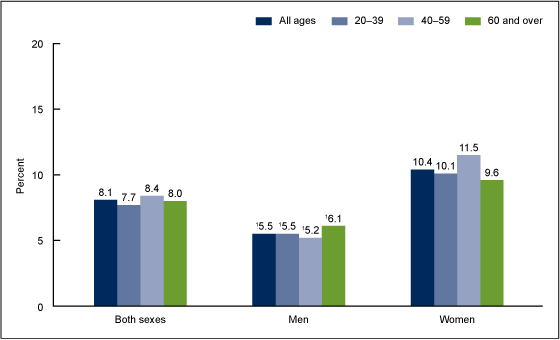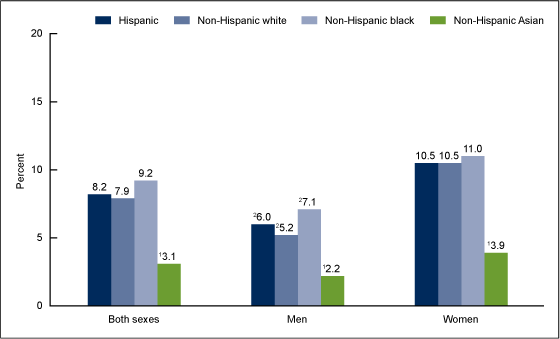Prevalence of Depression Among Adults Aged 20 and Over: United States
Key findings
Data from the National Health and Nutrition Examination Survey
PDF Versionpdf iconDuring 2013–2016, 8.1% of American adults aged 20 and over had depression in a given 2-week period.
Keywords: mental health, NHANES
During 2013–2016, 8.1% of Americans aged 20 and over had depression in a given 2-week period.
Figure 1. Percentage of persons aged 20 and over with depression, by age and sex: United States, 2013–2016
 image icon
image icon
1Significantly different from females in same age group.
NOTES: Depression was defined as a score greater than or equal to 10 on the Patient Health Questionnaire. Access data table for Figure 1pdf icon.
SOURCE: NCHS, National Health and Nutrition Examination Survey, 2013–2016.
The prevalence of depression was lower among non-Hispanic Asian adults than among any other race and Hispanic-origin group.
Figure 2. Percentage of persons aged 20 and over with depression, by race and Hispanic origin and sex: United States, 2013–2016
 image icon
image icon
1Significantly lower than Hispanic, non-Hispanic white, and non-Hispanic black.
2Significantly lower than women of the same race and Hispanic-origin group.
NOTES: Depression was defined as a score greater than or equal to 10 on the Patient Health Questionnaire. Access data table for Figure 2pdf icon.
SOURCE: NCHS, National Health and Nutrition Examination Survey, 2013–2016.
The prevalence of depression among adults decreased as family income levels increased.
Depression is classified as a mood disorder. It may be described as feelings of sadness, loss, or anger that interfere with a person’s everyday activities.
It’s also fairly common. The Centers for Disease Control and Prevention (CDC)Trusted Source estimates that 8.1 percent of American adults ages 20 and over had depression in any given 2-week period from 2013 to 2016.
People experience depression in different ways. It may interfere with your daily work, resulting in lost time and lower productivity. It can also influence relationships and some chronic health conditions.
Key findings
Data from the National Health and Nutrition Examination Survey
PDF Versionpdf iconDuring 2013–2016, 8.1% of American adults aged 20 and over had depression in a given 2-week period.
- Women (10.4%) were almost twice as likely as were men (5.5%) to have had depression.
- Depression was lower among non-Hispanic Asian adults, compared with Hispanic, non-Hispanic black, or non-Hispanic white adults.
- The prevalence of depression decreased as family income levels increased.
- About 80% of adults with depression reported at least some difficulty with work, home, and social activities because of their depression.
- From 2007–2008 to 2015–2016, the percentage of American adults with depression did not change significantly over time.
Keywords: mental health, NHANES
During 2013–2016, 8.1% of Americans aged 20 and over had depression in a given 2-week period.
- Overall, women (10.4%) were almost twice as likely to have depression as men (5.5%). This pattern also was observed among each age group (Figure 1).
- Among both men and women, the percentage with depression did not differ statistically across age groups.
Figure 1. Percentage of persons aged 20 and over with depression, by age and sex: United States, 2013–2016
 image icon
image icon1Significantly different from females in same age group.
NOTES: Depression was defined as a score greater than or equal to 10 on the Patient Health Questionnaire. Access data table for Figure 1pdf icon.
SOURCE: NCHS, National Health and Nutrition Examination Survey, 2013–2016.
The prevalence of depression was lower among non-Hispanic Asian adults than among any other race and Hispanic-origin group.
- Overall, non-Hispanic Asian adults had the lowest prevalence of depression (3.1%) compared with Hispanic (8.2%), non-Hispanic white (7.9%), and non-Hispanic black (9.2%) adults. This pattern was observed among both men and women (Figure 2).
- The prevalence of depression was not statistically different for Hispanic, non-Hispanic white, and non-Hispanic black adults, overall and among both men and women.
- Among all race and Hispanic-origin groups, except non-Hispanic Asian, men had a significantly lower prevalence of depression compared with women.
Figure 2. Percentage of persons aged 20 and over with depression, by race and Hispanic origin and sex: United States, 2013–2016
 image icon
image icon1Significantly lower than Hispanic, non-Hispanic white, and non-Hispanic black.
2Significantly lower than women of the same race and Hispanic-origin group.
NOTES: Depression was defined as a score greater than or equal to 10 on the Patient Health Questionnaire. Access data table for Figure 2pdf icon.
SOURCE: NCHS, National Health and Nutrition Examination Survey, 2013–2016.
The prevalence of depression among adults decreased as family income levels increased.
- Overall, 15.8% of adults from families living below the federal poverty level (FPL) had depression. The prevalence of depression decreased to 3.5% among adults at or above 400% of the FPL (Figure 3).
- Among both men and women, the prevalence of depression decreased with increasing levels of family income.
- Men with family incomes at or above 400% of the FPL had the lowest prevalence of depression (2.3%), while women with family incomes below the FPL had the highest prevalence (19.8%).
Depression is classified as a mood disorder. It may be described as feelings of sadness, loss, or anger that interfere with a person’s everyday activities.
It’s also fairly common. The Centers for Disease Control and Prevention (CDC)Trusted Source estimates that 8.1 percent of American adults ages 20 and over had depression in any given 2-week period from 2013 to 2016.
People experience depression in different ways. It may interfere with your daily work, resulting in lost time and lower productivity. It can also influence relationships and some chronic health conditions.
